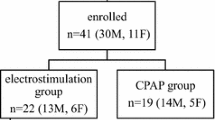Abstract
Phasic inspiratory genioglossus activity prevents pharyngeal airway collapse in healthy subjects during sleep and is diminished or absent in obstructive sleep apnoea syndrome (OSAS), thus leading to pharyngeal obstruction. Case reports of OSAS after pontomedullary lesions indicate that impaired inspiratory genioglossal activity may result from brainstem lesions. We therefore investigated brainstem functions in 18 awake patients with OSAS using brainstem auditory evoked potentials, blink reflex, masseter reflex, masseter inhibitory reflex (in 11 of 18 patients), magnetic evoked potentials of the tongue and electrooculography with vestibular testing. Fifteen of 18 patients showed no electrophysiological abnormalities. One patient had a left pontine and two patients a bilateral pontomesencephalic lesion, although a causal connection with OSAS was not conclusively confirmed. Our results do not support the assumption of a relevant structural brainstem lesion in OSAS patients with normal neurological findings.
Similar content being viewed by others
References
Adelman S, Dinner SD, Goen H, Little J, Nickerson P (1984) Obstructive sleep apnea in association with posterior fossa neurologic disease. Arch Neurol 41:509–510
Askenasy JJM, Goldhammer I (1988) Sleep apnea as a feature of bulbar stroke. Stroke 19:637–639
Chaudhary BA, Elguindi AS, King DW (1982) Obstructive sleep apnea after lateral medullary syndrome. South Med J 175:65–67
Chokroverty S (1980) Phasic tongue movements in human rapid-eye-movement sleep. Neurology 30:665–668
Funakawa I, Hara K, Yasuda T, Terao A (1993) Intractable hiccups and sleep apnea syndrome in multiple sclerosis: report of two cases. Acta Neurol Scand 88:401–405
Guilleminault C, Hill MW, Simmons FB, Dement WC (1978) Obstructive sleep apnea: electromyographic and fiberoptic studies. Exp Neurol 62:48–67
Haponik EF, Givens D, Angelo J (1983) Syringobulbia-myelia with obstructive sleep apnea. Neurology 33:1046–1049
Henn V (1993) Electronystagmography: the answers one might get. In: Caplan LR, Hopf HC (eds) Brain-stem localization and function. Springer, Berlin Heidelberg New York, pp 93–101
Hopf HC (1994) Topodiagnostic value of brain stem reflexes. Muscle Nerve 17:475–484
Hopf HC, Thömke F, Gutman L (1991) Midbrain vs pontine medial longitudinal fasciculus lesions: the utilization of masseter and blink reflexes. Muscle Nerve 14:326–330
Jiang C, Shen E (1991) Respiratory neurons in the medulla of the rabbit: distribution, discharge patterns and spinal projections. Brain Res 541: 284–292
Jung R, Kornhuber HH (1964) Results of electronystagmography in man: the values of optokinetic, vestibular, and spontaneous nystagmus for neurologic diagnosis and research. In: Bender MB (ed) The oculomotor system. Harper and Row, New York, pp 428–488
Kapen S, Saad J, Koshorek G (1989) A polysomnographic study of multiple sclerosis. Sleep Res 8:340
Karnaze D, Gott P, Mitchell F, Loftin J (1984) Brainstem auditory evoked potentials are normal in idiopathic sleep apnea. Ann Neurol 15:406
Maurer K, Schäfer E, Hopf HC, Leitner H (1980) The location by early auditory evoked potentials (EAEP) of acoustic nerve and brainstem demyelination in multiple sclerosis (MS). J Neurol 223:43–58
Mosko SS, Pierce S, Holowach J, Sassin JF (1981) Normal brain stem auditory evoked potentials recorded in sleep apneics during waking and as a function of arterial oxygen saturation during sleep. Electroencephalogr Clin Neurophysiol 51:477–482
Parkes JD (1985) Sleep and its disorders. Saunders, London
Salazar-Grueso EF, Rosenberg RS, Roos RS (1988) Sleep apnea in olivopontocerebellar degeneration: treatment with trazodone. Ann Neurol 23:399–401
Sauerland EK, Harper RM (1976) The human tongue during sleep: electromyographic activity of the genioglossus muscle. Exp Neurol 51: 160–170
Sauerland EK, Orr WC, Hairston LE (1981) EMG patterns of oropharyngeal muscles during respiration in wakefulness and sleep. Electromyogr Clin Neurophysiol 21:307–316
Simon RP (1993) Respiratory manifestations of neurologic disease. In: Vinken P, Bruyn G, Klawans H (eds) Handbook of clinical neurology, vol 19 (63). Elsevier, Amsterdam, pp 477–501
Snyderman NL, Johnson JT, Moller M, Thearle PB (1982) Brainstem evoked potentials in adult sleep apnea. Ann Otol Rhinol Laryngol 91:597–598
Urban PP, Hopf HC (1992) Masseter-Innervationspausen (silent periods) nach Stimulation des N. medianus, Plexus cervicalis und N. mentalis. Z EEG EMG 23:48–53
Urban PP, Heimgärtner I, Hopf HC (1994) Transkranielle Stimulation der Zungenmuskulatur bei Gesunden und Patienten mit Encephalomyelitis disseminata. Z EEG EMG 25:254–258
Verma NP, Kapen S, King SD, Koshorek GJ (1987) Bimodality electrophysiologic evaluation of brainstem in sleep apnea syndrome. Neurology 37:1036–1039
Author information
Authors and Affiliations
Rights and permissions
About this article
Cite this article
Urban, P.P., Schlegel, J., Ellrich, J. et al. Electrophysiological brainstem investigations in obstructive sleep apnoea syndrome. J Neurol 243, 171–174 (1996). https://doi.org/10.1007/BF02444011
Received:
Revised:
Accepted:
Issue Date:
DOI: https://doi.org/10.1007/BF02444011




